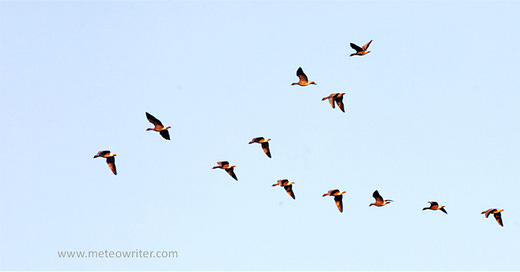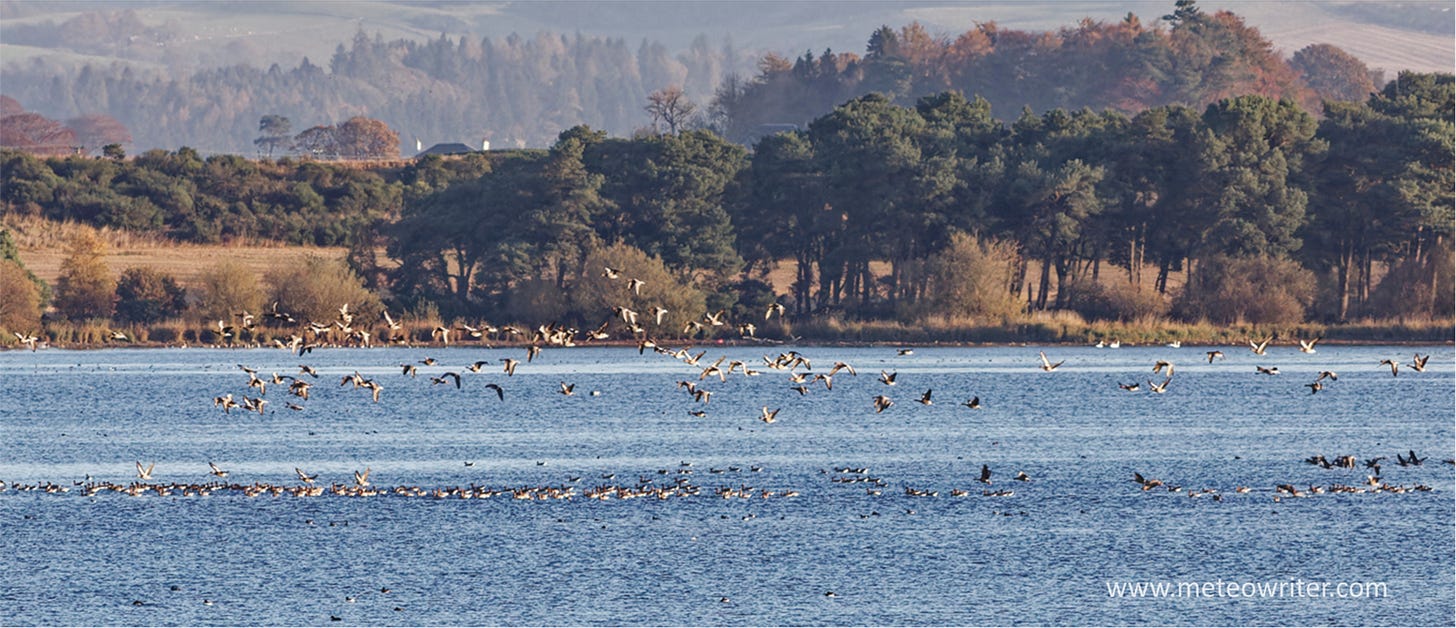As the days get shorter, one impressive sight around our way is that of huge skeins of geese flying overhead in V-shaped formations. Some are no doubt in transit, but others just on their daily commute to feed inland after spending the night roosting on open water for safety.
For pink-footed geese, one of the places they settle is at Loch Leven in central Scotland, which sometimes sees up to about 20,000 during the winter months. This year, the first arrivals were on around 9 September during the transition from a mild, wet spell to colder northerly winds.
Having spent the brief Arctic summer nesting in central Iceland, pink-footed geese take to open water and spend 25 days afloat, moulting their wing feathers before their flight south. One mid-autumn day, with the wind in the right direction, and temperature and food levels dropping, pink-footed families take off… From the website of the Wildlife Trusts
As the Met Office’s September 2024 Monthly Weather Report says ‘… from the 10th to the 12th, the UK found itself under the influence of a cool and showery northerly airstream and any significant rainfall confined to northern Scotland.’ Surface pressure charts in the lead up to the change show a large area of high pressure in the mid Atlantic with lows over the UK and to the north of Iceland drifting off east. This allowed a northerly airstream to become established on the 9th which covered the whole of the UK by the 10th and persisted for the next two days.
A skein of pink-footed geese passing overhead at Loch Leven
As master aviators, Iceland’s pink-footed geese took advantage of these tailwinds to make their annual dash south. For example, further north at the Scottish Wildlife Trust’s Montrose Basin reserve, 15,000 had arrived by the 15th up from just 15 the Sunday before, according to their social media feed.
It’s easy to imagine that flight times must have been significantly reduced by these following winds, even considering that some geese may have stopped over in the Faroe Islands. For example, assuming an average flight speed of 40km/h, the 1200km flight from Iceland to central Scotland would take about 30 hours non stop in still air, but could be less than half that with a strong tailwind. Quite impressive really when you consider that Icelandair’s scheduled flights from Reykjavik to Glasgow take just under 2.5 hours.
For nature enthusiasts, the sight and sound of so many birds in flight has made the annual goose migration something of an annual must-watch natural spectacle. As a result, a couple of weeks ago saw us on the shores of Loch Leven at sunrise for a Nature Scot dawn goose watch.
Here the birds roost on a low island to the north of the loch and in shallow waters to the east, and when food is in short supply start to fly inland soon after the sun appears. However, we had a longer wait, which Jeremy - our Nature Scot ranger - thought was probably because at this time of year there was still a ready supply of high calorie spilled grain in the fields, reducing the urgency to feed.
In the meantime, we had the pleasure of watching some of the loch’s other residents, including whooper swans, cormorants, lapwings, and some roe deer, grazing in the quiet of the morning sunshine.
The geese did eventually stir though, and by about 0830 some of those nearest our viewpoint took flight, heading inland in small groups. We also saw larger skeins passing overhead and at one point huge numbers lifted in the distance just visible against the rising sun.
Late rising pink-footed geese heading inland to feed at Loch Leven
We also learnt that other goose species seen at the loch include white-fronted geese and Canada geese, the occasional barnacle goose and, on rare occasions, snow geese, which normally migrate to the USA and Canada. The number of pink-footed geese typically varies over the winter with some staying but others heading south to locations such as the Wash as loch levels rise and food availability drops.
Pink-footed geese spotted much further south a few years ago on the Dee Estuary in north Wales
Further reading
Loch Leven National Nature Reserve website. For more background on the reserve and the species found there.
Quantum Robins and barnacle geese migration. For insights into how geese and other birds navigate over such huge distances, Kevin Sene, 2024:
https://naturestidings.substack.com/p/quantum-robins
Spectacular Britain: A spotter's guide to the UK’s most amazing natural phenomena: Kevin Sene, Bloomsbury, 2024. For further insights into geese migration and when and where to see large numbers in the UK.
https://www.bloomsbury.com/uk/spectacular-britain-9781844866342/








Wonderful! I haven't seen any skeins of pink footed geese yet this year! Usually by now I've seen a few over Edinburgh.....
I've never seen pink footed geese before, Kevin, but I'm pleased to see your photo of them on the Welsh Dee estuary. I'll look out for them next time I'm down by the estuary during autumn.